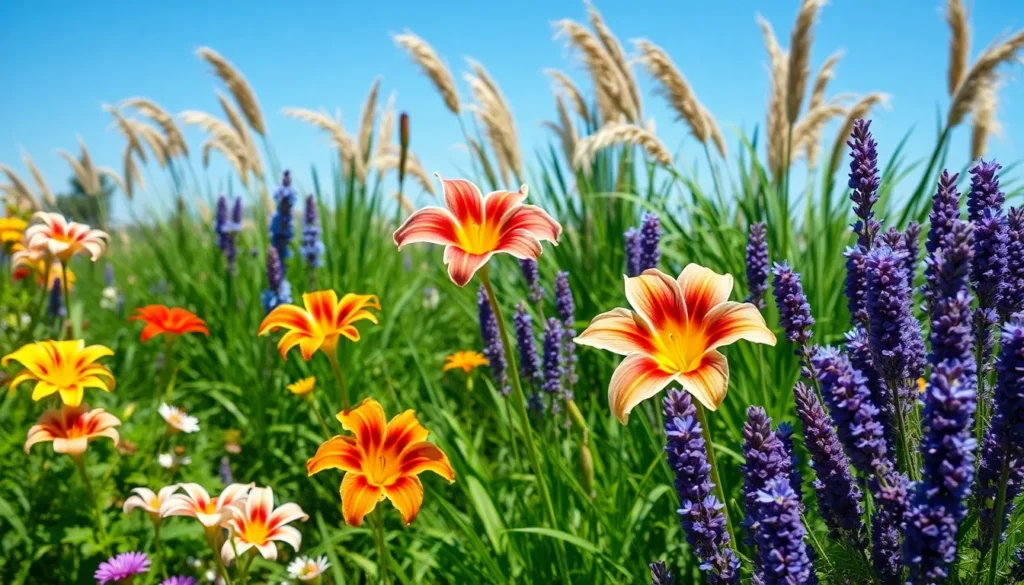We’ve all experienced the heartbreak of watching our favorite flowers fade as winter approaches. But what if we told you there’s a way to enjoy stunning blooms year after year without replanting? Perennial plants are nature’s gift to gardeners who want maximum beauty with minimal effort.
These remarkable plants return season after season, growing stronger and more spectacular with each passing year. From vibrant daylilies to fragrant lavender, perennials create the backbone of any successful garden design. They’ll reward your initial investment with decades of reliable color and texture.
The best part? Once established, most perennials require far less maintenance than their annual counterparts. We’re talking about plants that’ll survive harsh winters, bounce back with vigor each spring, and often multiply to fill your garden with even more beauty. Ready to discover which perennial powerhouses deserve a spot in your industry?
Understanding Perennial Plants That Come Back Every Year
Now that we’ve explored the lasting appeal of perennial plants, let’s dive deeper into what makes these garden favorites such reliable performers year after year.
What Makes Plants Return Annually
Perennial plants develop robust root systems that survive winter conditions and store energy for the following growing season. These hardy roots remain dormant underground during cold months, then emerge with new growth when temperatures warm in spring. We see this remarkable adaptation in plants like peonies, which can live for decades once their root systems mature.
Root structures vary among perennial types, with some forming thick crowns like hostas while others spread through underground rhizomes like irises. Most perennials enter a natural dormancy period where above-ground foliage dies back, but the root system continues living. This survival mechanism allows energy storage that fuels vigorous spring growth without requiring replanting.
Temperature tolerance plays a crucial role in determining which perennials return in exact climates. Hardy perennials like black-eyed Susans withstand freezing temperatures down to USDA zone 3, while tender perennials such as dahlias need protection or lifting in colder regions. We find that understanding your hardiness zone helps predict which plants will reliably return each year.
Benefits of Growing Perennial Plants
Cost effectiveness stands out as a primary advantage since we purchase perennial plants once but enjoy years of blooms and foliage. A single daylily plant costing $15 can provide beautiful flowers for 15-20 years, making the per-year cost less than $1. This economic benefit becomes even more pronounced when perennials multiply naturally through division.
Low maintenance requirements make perennals ideal for busy gardeners who want attractive landscapes without constant replanting. Most established perennials need only annual cleanup, occasional watering during dry spells, and periodic division every 3-5 years. We appreciate that mature perennial gardens practically maintain themselves compared to annual flower beds requiring complete replanting each season.
Environmental benefits include improved soil structure as perennial roots grow deeper than annual plants, reducing erosion and improving water infiltration. These permanent plantings provide consistent habitat for beneficial insects and birds throughout multiple seasons. We observe that perennial gardens support local ecosystems better than constantly disturbed annual beds.
Difference Between Perennials, Annuals, and Biennials
Perennials live for three or more years, returning each growing season from their established root systems. Popular examples include coneflowers, daylilies, and ornamental grasses that provide reliable garden structure year after year. We plant perennials knowing they’ll become permanent garden features that often improve with age.
Annuals complete their entire life cycle in one growing season, from seed to flower to seed production before dying. Marigolds, impatiens, and petunias fall into this category, requiring replanting each year but offering continuous blooms throughout their single season. These plants focus all their energy on flower production since they won’t return.
Biennials bridge the gap between annuals and perennials, taking two years to complete their life cycle. During year one, plants like foxgloves and hollyhocks establish roots and foliage, then flower and set seed in year two before dying. We often treat biennials as short-lived perennials since they may self-seed and appear to return annually in the garden.
| Plant Type | Lifespan | Replanting Needed | Examples |
|---|---|---|---|
| Perennials | 3+ years | No | Coneflowers, daylilies, hostas |
| Annuals | 1 season | Yes | Marigolds, impatiens, petunias |
| Biennials | 2 years | Sometimes | Foxgloves, hollyhocks, sweet William |
Low-Maintenance Flowering Plants That Come Back Every Year
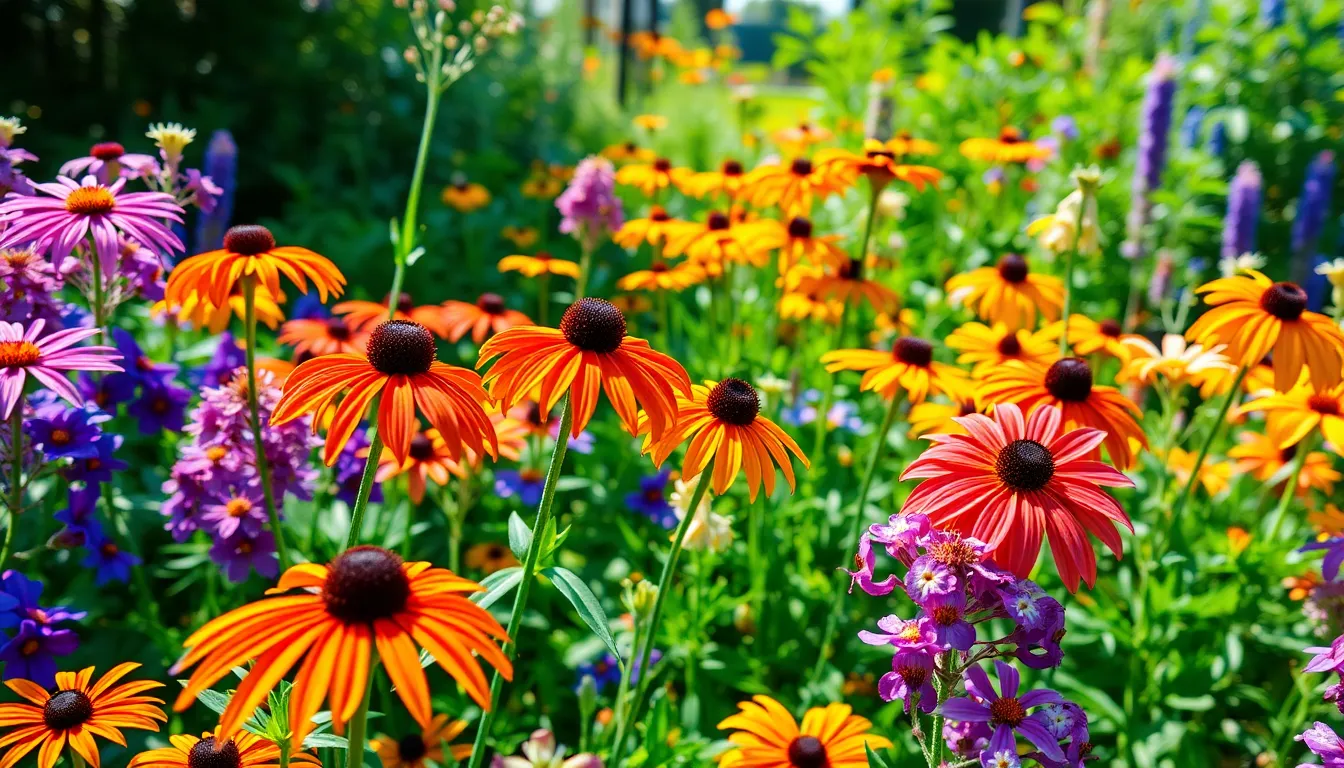
Building on our perennial foundation, we’ve selected four exceptional flowering plants that require minimal care while delivering stunning seasonal displays year after year.
Black-Eyed Susan (Rudbeckia)
Black-Eyed Susans thrive in full sun conditions with temperatures of 60°F and above, making them perfect for most growing zones. These cheerful yellow blooms prefer well-draining soil with a pH around 6.8 and don’t require rich, nutrient-heavy ground to flourish. We recommend watering them about an inch per week during their first growing season, after which they become remarkably drought-resistant.
Plant spacing is crucial for Black-Eyed Susans since good air circulation prevents powdery mildew from developing. Many Rudbeckia varieties are short-lived perennials or biennials, but they self-seed readily to ensure continuous blooms in your garden. Fertilizer needs are minimal, with simple compost providing sufficient nutrients for healthy growth.
Purple Coneflower (Echinacea)
Purple Coneflowers establish themselves as hardy perennials that attract beneficial pollinators like bees and butterflies to your garden space. Full sun exposure paired with well-drained soil creates optimal growing conditions for these stunning purple blooms. Once established, they require minimal intervention from gardeners while producing consistent seasonal displays.
Drought tolerance makes Purple Coneflowers ideal for water-conscious gardening approaches. Their robust root systems store energy effectively during winter months, ensuring reliable spring emergence year after year.
Daylilies (Hemerocallis)
Daylilies adapt to various soil types and growing conditions, making them one of our most versatile perennial recommendations. Their vibrant blooms range from yellow and orange to deep red and purple, providing endless color combinations for garden design. These plants multiply naturally over time, creating larger clumps that produce more flowers each season.
Drought tolerance and low maintenance requirements make daylilies perfect for busy gardeners who want reliable results. We’ve found they perform well in both full sun and partial shade locations throughout most hardiness zones.
Bee Balm (Monarda)
Bee Balm flourishes in full sun to partial shade conditions with moist, well-drained soil that supports its spreading growth habit. Hummingbirds and bees are naturally drawn to these fragrant, colorful blooms that appear in summer months. The plants form attractive clumps that expand gradually, creating natural colonies in suitable growing spaces.
Minimal care requirements make Bee Balm an excellent choice for naturalized garden areas. Their ability to spread and self-propagate ensures continuous coverage and blooms without replanting efforts from gardeners.
Shade-Loving Plants That Come Back Every Year
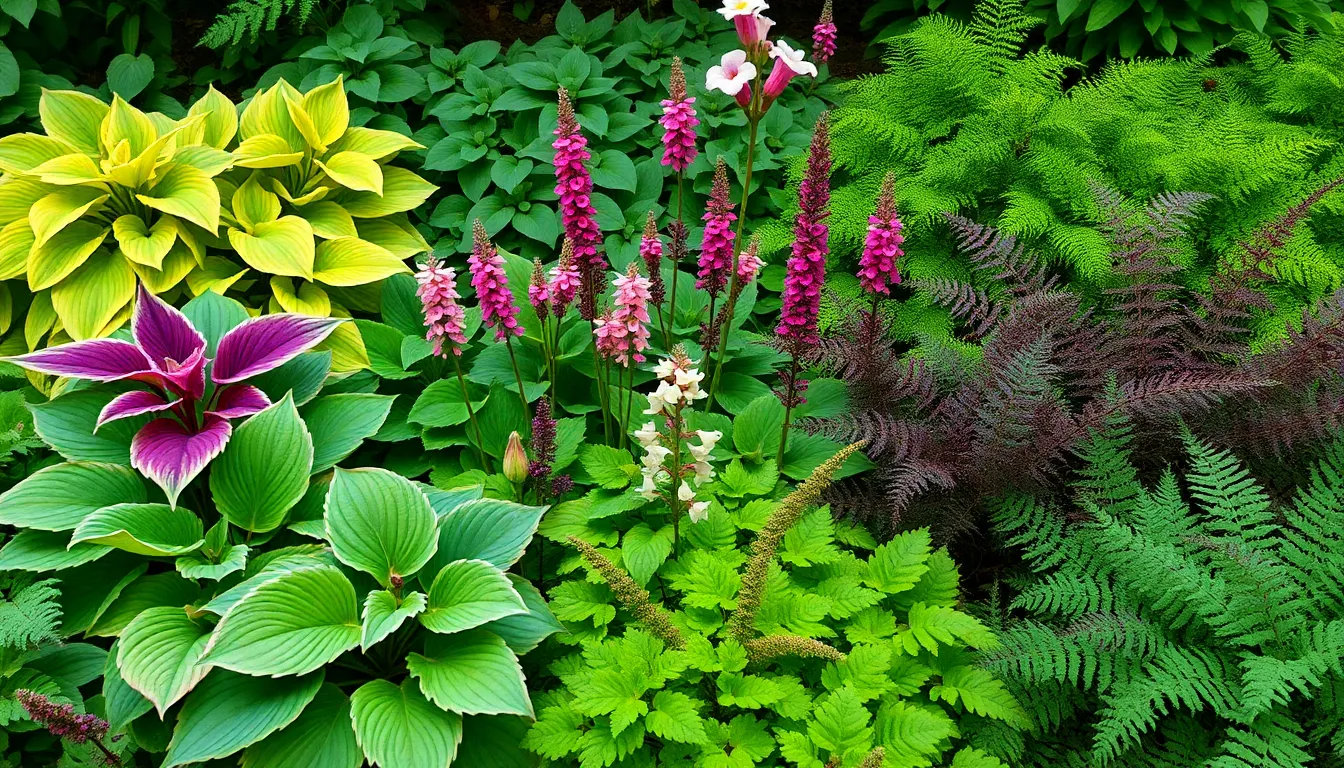
Shaded areas don’t have to be boring or lifeless when you choose the right perennials. These shade loving plants that come back every year transform darker garden spots into vibrant, textured landscapes that thrive without direct sunlight.
Hostas
Hostas rank among the most reliable shade perennials for creating lush, dense ground cover year after year. We love how these plantain lilies offer incredible foliage variety, from deep green to blue and striking variegated patterns that brighten any shaded corner.
Establishing hostas in moist, well drained soil gives you decades of consistent beauty. Their robust root systems store energy through winter months, allowing them to emerge stronger each spring. Size options range from miniature varieties perfect for containers to giant specimens that can reach three feet wide.
Astilbe
Astilbe brings stunning summer color to shaded gardens with its distinctive feathery plume flowers. These perennials produce delicate flower clusters in pink, red, white, and lavender shades that create dramatic focal points in darker areas.
Moisture loving astilbes thrive in consistently moist soil and return reliably each year to brighten your shade garden. We recommend planting them near water features or in naturally damp spots where their vibrant blooms can truly shine. Their fern like foliage remains attractive even after flowers fade.
Coral Bells (Heuchera)
Coral bells offer year round interest with their spectacular foliage colors ranging from deep purples to bright lime greens. These hardy perennials create beautiful texture contrast in shade gardens while requiring minimal maintenance once established.
Elegant flower spikes emerge in late spring to early summer on many varieties, adding vertical interest to garden designs. We appreciate how coral bells adapt to various light conditions, from full shade to partial sun. Their compact size makes them perfect for border plantings or container gardens.
Japanese Painted Fern
Japanese painted ferns stand out as exceptional foliage plants with their silvery gray fronds and striking dark purple stems. These unique perennials create dramatic visual impact in shaded areas where other plants might struggle.
Thriving in moist, well drained conditions, Japanese painted ferns return each year with even more beautiful fronds. We find their metallic appearance particularly stunning when paired with darker green hostas or colorful coral bells. Their texture adds sophisticated elegance to any shade garden design.
Sun-Loving Plants That Come Back Every Year
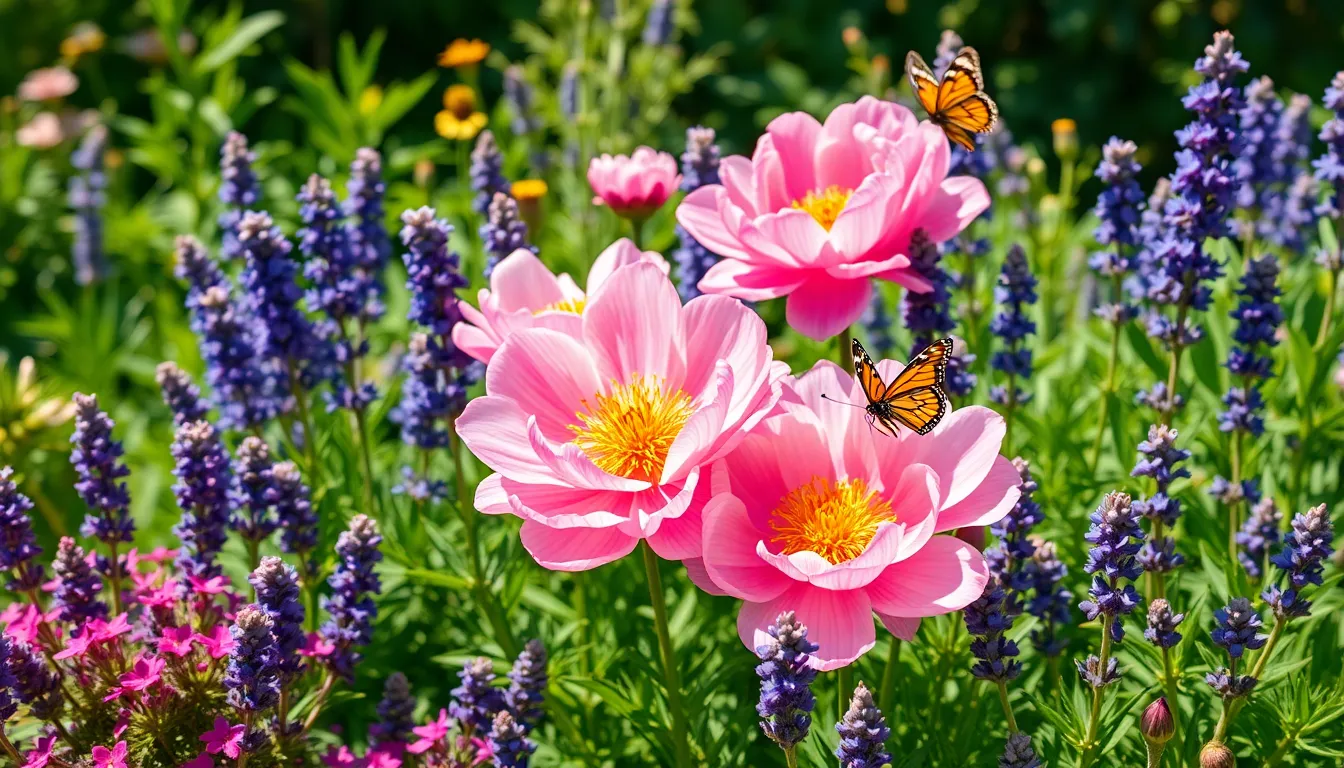
For gardeners seeking vibrant perennials that thrive in full sun conditions, these four exceptional plants deliver lasting beauty with minimal care requirements.
Peonies
Peonies stand out as some of the most rewarding perennials we can plant in sunny garden spaces. These long-lived beauties produce large, fragrant blooms each spring and can thrive for decades once properly established. Full sun exposure and well-drained soil create the ideal growing conditions for these stunning perennials. We love how peonies reward gardeners with increasingly impressive displays as they mature, making them excellent investments for permanent garden features.
Lavender
Lavender brings both beauty and functionality to our sunny perennial gardens with its distinctive silvery foliage and purple flower spikes. This drought-tolerant perennial flourishes in full sun locations and well-drained soil conditions, requiring minimal water once established. Pollinators like bees and butterflies flock to lavender’s fragrant blooms throughout the growing season. We appreciate how the aromatic leaves can be harvested for cooking projects and create applications, making lavender a versatile addition to any sunny garden space.
Sedum (Stonecrop)
Sedum varieties offer us an extensive selection of drought-tolerant succulents that excel in full sun environments. These remarkable plants feature fleshy leaves that store water efficiently and produce clusters of star-shaped flowers during late summer or fall months. Rock gardens and sunny borders benefit tremendously from sedum’s low-maintenance nature and unique texture. We find these perennials particularly valuable for challenging garden spots where other plants might struggle to survive.
Russian Sage
Russian sage delivers impressive visual impact through its aromatic gray-green foliage and tall spikes of lavender-blue flowers that bloom from early summer through fall. This robust perennial demonstrates excellent drought tolerance while remaining resistant to deer damage and common plant diseases. Pollinators including hummingbirds and butterflies visit Russian sage regularly throughout its extended blooming period. We recommend this perennial for gardeners wanting substantial height and structure in their sunny garden designs without intensive maintenance requirements.
Ornamental Grasses That Come Back Every Year
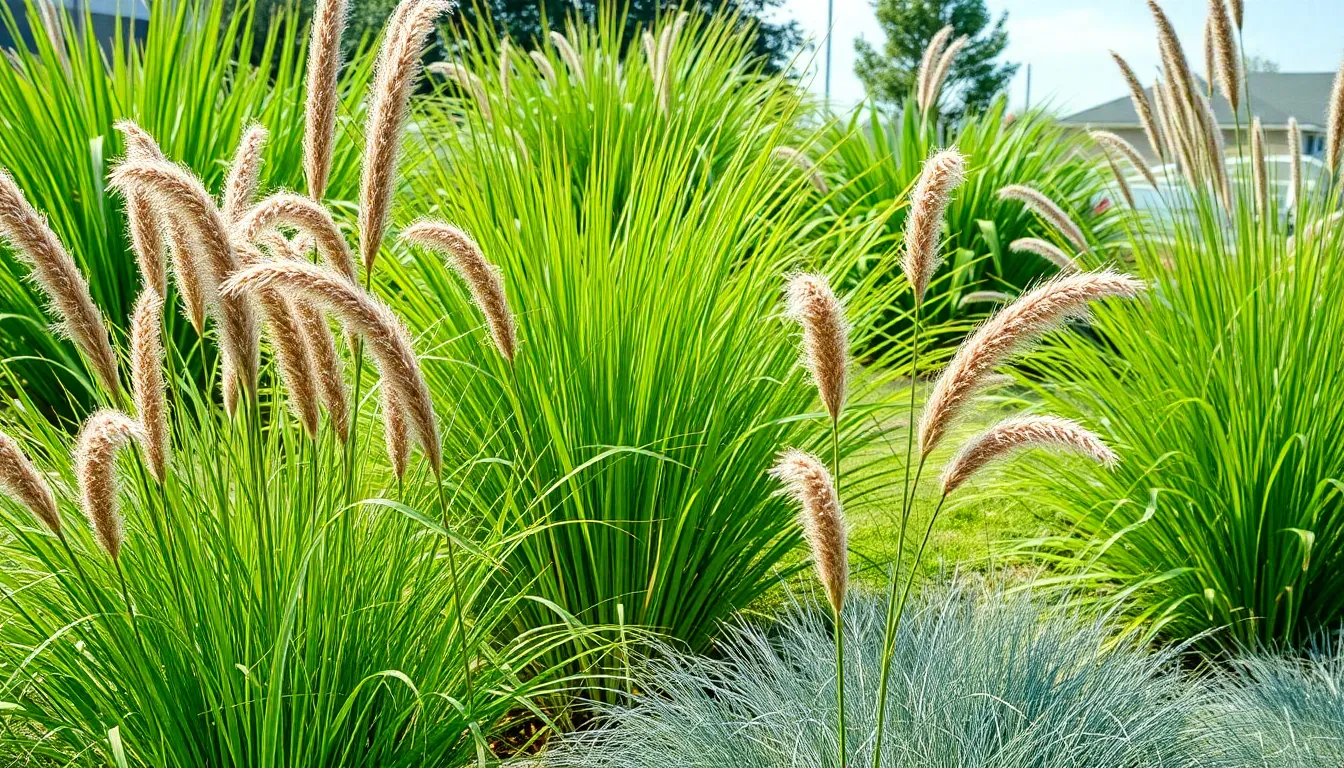
Moving beyond traditional flowering perennials, ornamental grasses offer unique texture and movement while returning year after year. These resilient plants survive winter through robust root systems and provide architectural interest throughout the seasons.
Fountain Grass
Fountain grass delivers graceful flower spikes and arching foliage that creates stunning visual drama in our gardens. This hardy perennial thrives in full sun to partial shade and adapts to various soil conditions. Drought tolerance makes it an excellent choice for water conscious gardeners once the root system establishes. We’ll notice the distinctive arching habit reaches 2 to 4 feet tall, creating natural movement with every breeze.
Planting fountain grass in spring allows the roots to develop before winter dormancy begins. Winter brings complete dieback of above ground growth, but the underground root system remains alive and vigorous. Spring emergence reveals fresh green shoots that quickly develop into the characteristic fountain shape we love.
Ornamental Millet
Ornamental millet produces colorful seed heads that add striking vertical accents to our perennial borders. Growing 3 to 6 feet tall, this grass performs well in various soil types from sandy to clay. Full sun exposure maximizes the intensity of seed head colors, which range from burgundy to golden bronze.
Established root systems ensure reliable return each growing season, making ornamental millet a dependable choice for our landscapes. Cutting back the previous year’s growth in early spring prepares space for new shoots to emerge. Seeds often self sow, creating natural colonies that expand our ornamental grass displays over time.
Feather Reed Grass
Feather Reed grass stands out with upright, narrow plumes that provide excellent vertical interest in our garden designs. This extremely hardy perennial tolerates both drought and wet conditions once established. Height typically reaches 4 to 6 feet, making it perfect for background plantings or as specimen features.
Clumping growth habit prevents aggressive spreading while still filling designated spaces effectively. We can rely on consistent performance year after year, as feather reed grass rarely requires division or special winter protection. The sturdy stems hold their form through winter, offering structural beauty even in dormant seasons.
Blue Fescue
Blue fescue forms compact clumps with distinctive silver blue foliage that remains attractive throughout most of the year. This evergreen perennial maintains its color in mild winter climates, providing continuous garden interest. Mature size stays manageable at 8 to 12 inches tall and wide, perfect for edging or rock gardens.
Minimal maintenance requirements make blue fescue ideal for busy gardeners who want reliable performance. Well draining soil prevents root rot, the primary concern with this otherwise bulletproof grass. Regular division every 3 to 4 years rejuvenates older clumps and provides new plants for expanding our blue fescue collections.
Native Plants That Come Back Every Year by Region
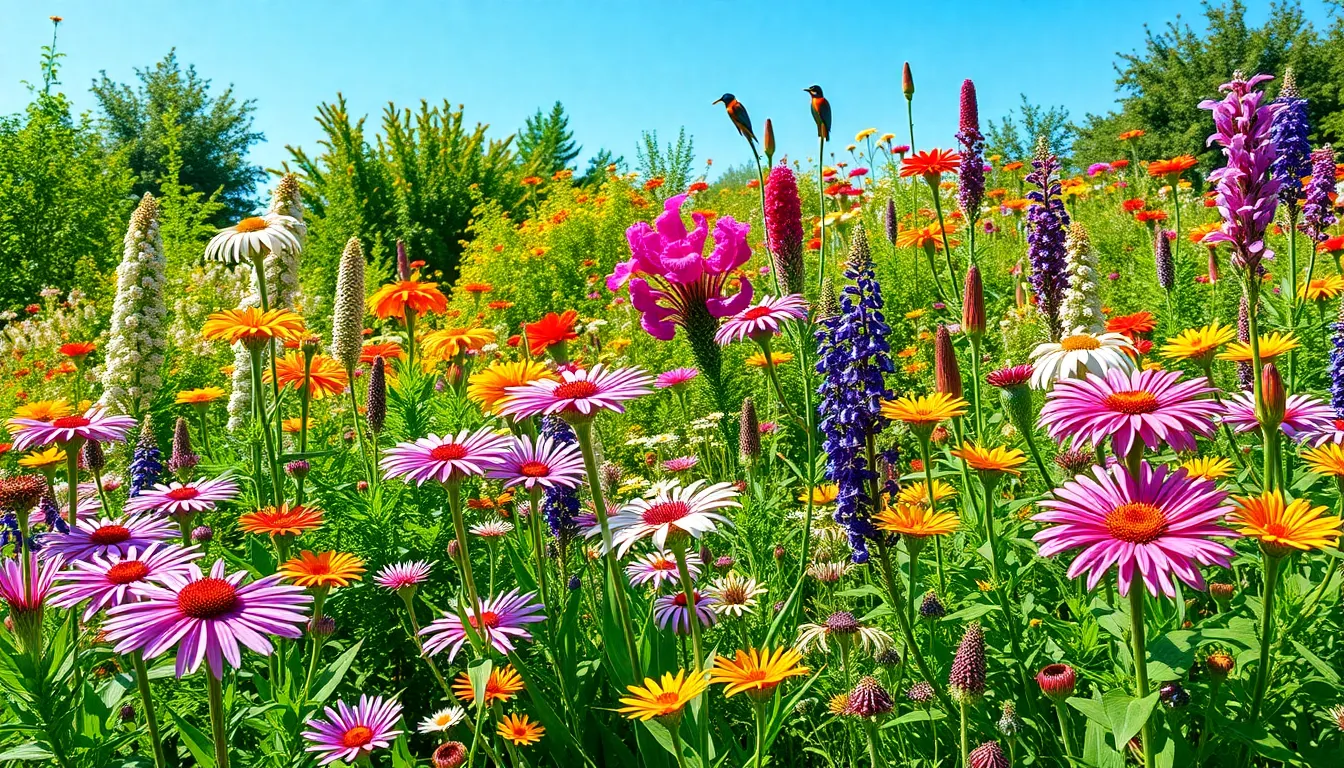
Native perennials offer the perfect combination of sustainability and beauty while supporting local ecosystems. We’ve organized these remarkable plants by region to help you choose species that’ll thrive naturally in your exact climate.
Eastern United States Native Perennials
Heuchera americana (Alumroot) leads our list of exceptional Eastern native perennials that return reliably each year. This stunning plant produces delicate flower spikes and thrives in the Mixed Wood Plains ecoregion with minimal maintenance requirements.
Wildflower collections designed for Eastern climates provide diverse options that support bees, butterflies, and other essential wildlife. These resilient plants adapt perfectly to regional soil conditions and weather patterns.
Biodiversity support becomes effortless when you choose Eastern native perennials, as they’ve evolved alongside local insects and animals. We recommend consulting native plant societies for species-exact guidance in your area.
Western United States Native Perennials
Heuchera micrantha represents the Western adaptation of the popular Heuchera genus, offering unique characteristics suited to drier Western climates. This perennial creates sustainable landscapes that require less water than traditional garden plants.
Locally native wildflowers provide the best foundation for Western gardens, as they’re naturally equipped to handle temperature extremes and varying precipitation levels. Some Western native perennials may spread vigorously, creating natural colonies that support native insects.
Climate adaptation makes Western native perennials particularly valuable for gardeners seeking low maintenance answers. We suggest researching your exact ecoregion to identify the most suitable native species for your industry.
Southern United States Native Perennials
Southeastern USA Plains ecoregion supports many native perennial collections adapted to warmer temperatures and longer growing seasons. These plants excel in pollinator support while requiring minimal intervention from gardeners.
Habitat restoration becomes achievable with Southern native perennials that naturally thrive in regional conditions. They provide essential food sources and nesting materials for local wildlife throughout their extended growing periods.
Low maintenance gardening reaches new heights with Southern natives that can withstand heat, humidity, and occasional drought conditions. We find these plants particularly valuable for creating sustainable landscapes that maintain beauty year after year.
Northern United States Native Perennials
Cold tolerance defines Northern native perennials, which have adapted to withstand harsh winters and shorter growing seasons. These hardy plants emerge reliably each spring even though challenging weather conditions.
Wildlife support remains crucial even in northern climates, where native perennials provide essential resources for pollinators and other animals preparing for winter. Regional native plant nurseries offer the best selection of locally appropriate species.
Sustainable gardening becomes more achievable with Northern natives that don’t require protection or special care during winter months. We recommend using native plant finders to identify species that match your exact zip code and growing conditions.
Essential Care Tips for Plants That Come Back Every Year
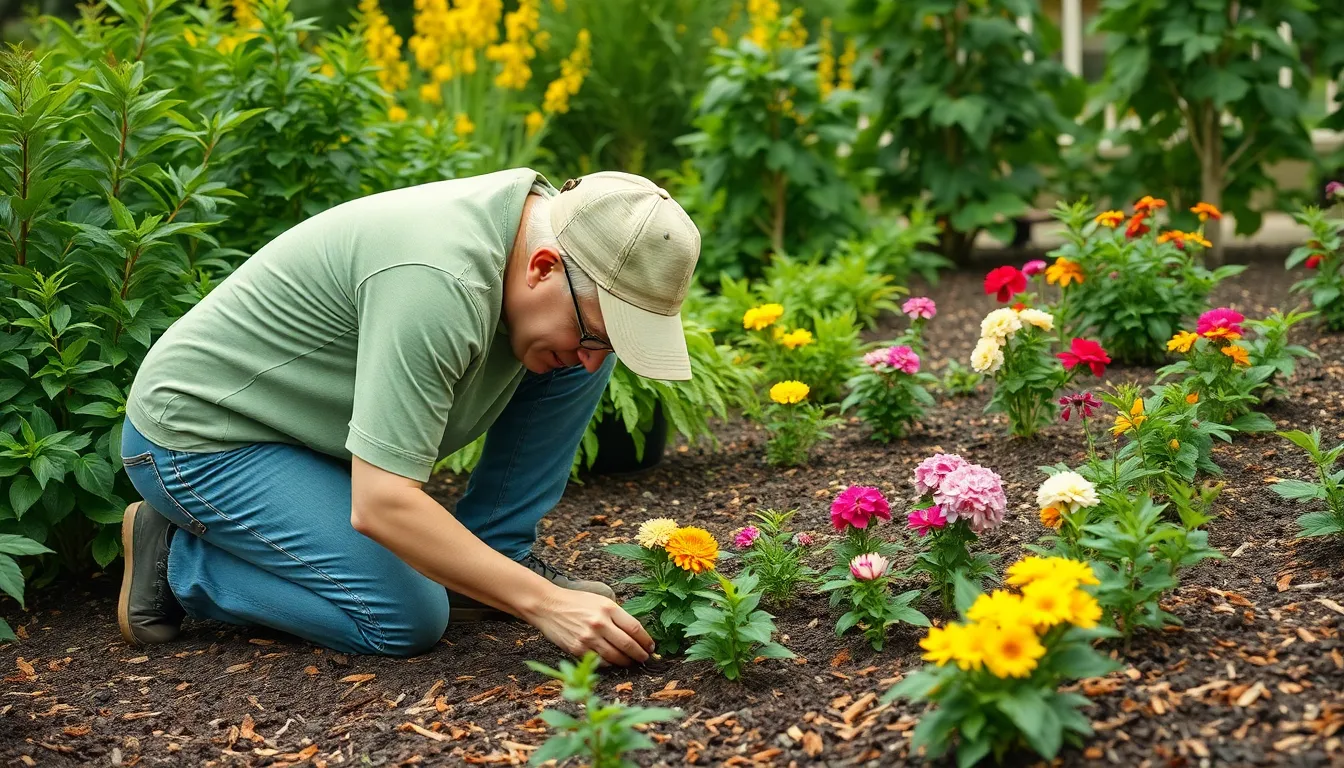
Understanding proper care techniques ensures our perennial plants thrive and return stronger each season. We’ll walk through the essential maintenance practices that keep these enduring beauties flourishing year after year.
Proper Planting Techniques
Soil preparation forms the foundation of successful perennial gardening. We recommend creating well-drained soil with good fertility and maintaining a pH between 6.0 and 7.0 for optimal plant health.
Incorporating organic matter into the soil improves both fertility and drainage before planting. Compost, aged manure, and leaf mold work exceptionally well for this purpose.
Clearing the planting area of weeds and stones helps roots establish better in their new environment. This simple step prevents competition and creates space for healthy root development.
Testing soil drainage before planting prevents future waterlogging issues. We suggest digging a hole 12 inches deep and filling it with water to ensure it drains within 24 hours.
Seasonal Maintenance Requirements
Spring cleaning tasks include removing last year’s dead stems and foliage to promote healthy new growth. This practice prevents disease and allows fresh shoots to emerge without obstruction.
Monitoring for pests becomes crucial during spring months when aphids and other insects emerge. We recommend using water sprays or insecticidal soap when necessary to control infestations naturally.
Watering deeply during the growing season maintains consistent soil moisture without creating overly wet conditions. Perennials prefer thorough, infrequent watering rather than light, frequent applications.
Mulching around plants helps retain moisture and suppress weeds throughout the growing season. Apply 2-3 inches of organic mulch, keeping it away from plant stems.
Fall fertilization prepares perennials for winter dormancy. We apply balanced fertilizer in mid to late fall to strengthen root systems before cold weather arrives.
Division and Propagation Methods
Dividing clump-forming perennials like Monarda, Phlox, and Aster rejuvenates older plants every 4 or more years. This process restores vigor and prevents overcrowding in established beds.
Lifting entire clumps requires careful digging around the plant’s root system. We use a sharp spade to cut through the soil and lift the complete root mass.
Cutting clumps into smaller pieces creates multiple new plants from one parent. Each division should contain healthy roots and several growing points or shoots.
Discarding dead or damaged portions ensures only healthy plant material gets replanted. We inspect each division carefully and remove any diseased or rotted sections.
Replanting with added organic matter gives divisions the best start in their new locations. Fresh compost or aged manure provides nutrients for establishing root systems.
Avoiding division works best for perennials with taproots or woody crowns like Agastache and Lavandula. These plants prefer to remain undisturbed once established.
Winter Protection Strategies
Providing mulch protection insulates root systems against temperature extremes during cold months. We apply 4-6 inches of organic mulch after the ground begins to freeze.
Choosing appropriate mulch materials includes straw, shredded leaves, or pine needles that won’t compact over winter. These materials allow air circulation while providing insulation.
Timing mulch application correctly prevents rodent nesting and premature growth. We wait until plants enter dormancy and temperatures consistently drop below freezing.
Maintaining fall fertilization strengthens plants to withstand winter stress. Proper nutrition in late fall helps perennials store energy for spring emergence.
Avoiding premature spring cleanup protects plants from late frost damage. We leave protective mulch in place until consistent warm weather arrives and new growth appears.
Conclusion
We’ve explored the incredible industry of perennials that return year after year bringing lasting beauty to our gardens. From sun-loving peonies to shade-thriving hostas and graceful ornamental grasses these remarkable plants offer endless possibilities for creating stunning landscapes that evolve and improve with time.
The journey to a thriving perennial garden starts with understanding our local growing conditions and selecting plants that match our climate and lifestyle. Whether we’re drawn to low-maintenance options like sedum or prefer the dramatic impact of native wildflowers there’s a perfect perennial waiting to transform our outdoor spaces.
By investing in these returning beauties we’re not just creating gardens – we’re building sustainable ecosystems that support local wildlife reduce maintenance demands and provide years of enjoyment for a fraction of the cost of annual replanting.
Frequently Asked Questions
What are the main benefits of growing perennial plants?
Perennials offer long-term value by returning year after year without replanting, making them cost-effective. They require less maintenance than annuals once established, have robust root systems that survive winter, and often multiply naturally. Perennials also provide environmental benefits like improved soil structure and support local ecosystems while offering continuous garden color and texture.
How do perennials survive winter and return each year?
Perennials survive through their robust root systems that store energy during growing seasons. These roots remain dormant underground during winter, protected from harsh temperatures. When spring arrives, the stored energy allows new growth to emerge. Different perennials like peonies and irises have unique root structures that contribute to their remarkable longevity and resilience.
What’s the difference between perennials, annuals, and biennials?
Perennials live for three or more years, returning each season from their root systems. Annuals complete their entire life cycle in one growing season and must be replanted yearly. Biennials take two years to complete their life cycle, typically growing foliage the first year and flowering the second year before dying.
Which perennials are best for low-maintenance gardens?
Black-Eyed Susan, Purple Coneflower, Daylilies, and Bee Balm are excellent low-maintenance choices. These plants are drought-resistant once established, attract beneficial pollinators, and require minimal care. They thrive in full sun conditions and provide vibrant blooms throughout the growing season while naturally multiplying to fill garden spaces.
What perennials grow well in shade?
Shade-loving perennials include Hostas (known for lush foliage), Astilbe (feathery summer blooms), Coral Bells (year-round interest), and Japanese Painted Ferns (dramatic foliage). These plants transform darker garden areas into vibrant landscapes and generally require less water than sun-loving varieties while providing unique textures and colors.
Which perennials thrive in full sun conditions?
Sun-loving perennials include Peonies (large, fragrant blooms), Lavender (drought-tolerant and aromatic), Sedum varieties (extremely low-maintenance), and Russian Sage (pest-resistant with striking appearance). These plants flourish in bright, sunny locations and are typically more drought-tolerant once established, making them perfect for sunny garden borders and landscapes.
Why should I choose native perennials for my garden?
Native perennials are adapted to local climate conditions, requiring less water and maintenance while supporting local ecosystems and wildlife. They provide food and habitat for beneficial insects, birds, and pollinators specific to your region. Native plants also promote biodiversity and sustainable gardening practices while typically being more resistant to local pests and diseases.
How do I properly care for perennial plants?
Plant perennials in well-drained soil enriched with organic matter. Provide seasonal maintenance including spring cleanup, regular watering during establishment, and monitoring for pests. Divide overcrowded plants every 3-5 years to maintain vigor. Apply mulch for winter protection in colder climates and cut back dead foliage as needed for plant health.

